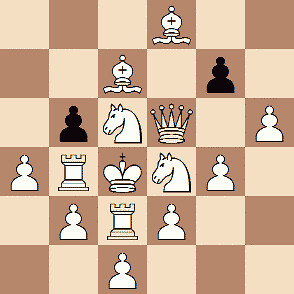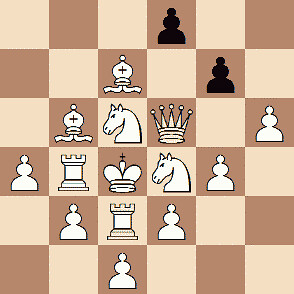A puzzle
post by Thomas · 2009-04-25T02:33:00.000Z · LW · GW · Legacy · 45 commentsContents
45 comments
What do these things have in common? Nerves, emotions, morality, prices.
45 comments
Comments sorted by top scores.
comment by ArisKatsaris · 2012-04-14T10:48:43.741Z · LW(p) · GW(p)
FIRST THOUGHT:
King can hit at most 8 pieces = 8
Queen can hit at most 8 pieces = 8
Each rook can hit at most 4 pieces = 2x4 = 8
Each bishop can hit at most 4 pieces =2x4 = 8
Each knight can hit at most 8 pieces = 2x8 = 16
Each pawn can hit at most 2 pieces = 8x2 = 16
So obviously the true answer can't possibly be above 64 connections.
Edit to add SECOND THOUGHT:
We can reduce this further. From all columns in which there are pieces, one piece atleast occupies the leftmost column, atleast one piece the rightmost column. These pieces will have their potential attacks limited, atleast by one (if these pieces are pawns), so the true answer can't possibly be above 62 connections.
Edited to fix bad arithmetic.
Replies from: Thomas↑ comment by Thomas · 2012-04-14T11:40:57.529Z · LW(p) · GW(p)
Each bishop can hit at most 4 pieces =2x4 = 12
8, actually.
Replies from: ArisKatsaris↑ comment by ArisKatsaris · 2012-04-14T12:26:13.319Z · LW(p) · GW(p)
lol, yeah, thanks.
comment by orthonormal · 2012-04-14T13:48:38.763Z · LW(p) · GW(p)
Unless there's some clever structure to the optimal position, this is a problem best solved by computer search. Potentially it could make a good Project Euler problem, potentially not (depending on how much computation the best human-writable program requires to do it).
Also, this post gave the false impression that there was a known answer. That irritated me when I read the comments.
Replies from: gRR↑ comment by gRR · 2012-04-14T14:06:02.088Z · LW(p) · GW(p)
I think I can prove 53 is the maximum. And the solution does have a nice structure.
Replies from: Thomas↑ comment by Thomas · 2012-04-14T15:28:52.075Z · LW(p) · GW(p)
Prove it, since your answer is correct, as far as I know.
Can you answer for the case of the two sets of pieces? Black and white, 32 of them. Again the color does not matter.
Replies from: gRR↑ comment by gRR · 2012-04-14T17:10:46.872Z · LW(p) · GW(p)
No, I'll leave it to you for now.
For two sets, the answer is 118.
Replies from: Thomas↑ comment by Thomas · 2012-04-14T17:14:30.557Z · LW(p) · GW(p)
119.
Replies from: gRR↑ comment by gRR · 2012-04-14T17:43:35.515Z · LW(p) · GW(p)
According to my proof, more than 128-10 is impossible. Are you sure?
Replies from: Thomas↑ comment by Thomas · 2012-04-14T18:01:56.568Z · LW(p) · GW(p)

↑ comment by gRR · 2012-04-14T19:02:58.270Z · LW(p) · GW(p)
Thanks! Clever trick with a rook and two bishops to reduce the length of the top boundary, I missed it.
Cebbs fxrgpu sbe n fvatyr frg: svefg, pbafvqre gjb xavtugf naq n xvat. Rnfl gb frr gurl unir ng yrnfg 4 serr pbaarpgvbaf, ab znggre ubj bgure cvrprf ner cynprq. Gura pbafvqre gur gbc obhaqnel (=cvrprf jvgu ng yrnfg bar serr hcjneq ovfubc-zbir naq ng yrnfg bar serr ebbx-zbir). Gur gbc obhaqnel pna'g or yrff guna 6 cvrprf, rnpu jvgu ng yrnfg bar serr pbaarpgvba, naq ng yrnfg bar bs gur obhaqnel cvrprf unf abguvat va gur ebjf nobir vg, fb vg unf ng yrnfg gjb serr pbaarpgvbaf. Nygbtrgure 64-(4+6+1)=53.
Replies from: Thomas, TrE↑ comment by TrE · 2012-04-14T20:55:09.689Z · LW(p) · GW(p)
Can you give a position for 53 'bounds'?
Replies from: gRR↑ comment by gRR · 2012-04-14T21:12:49.347Z · LW(p) · GW(p)
Replies from: ArisKatsaris↑ comment by ArisKatsaris · 2012-04-14T22:00:55.403Z · LW(p) · GW(p)
Then the clarification mentioned in a comment:
"the 16 white pieces" can be mixed colors, doesn't matter.
is false, because by turning the pawn of the second row, and the first pawn of the third row into black pieces, we go up to 55 connections from 53.
Replies from: Thomas↑ comment by Thomas · 2012-04-15T09:31:44.265Z · LW(p) · GW(p)
Makes no sense to me what you said. Can you please clarify?
Replies from: ArisKatsaris, ArisKatsaris↑ comment by ArisKatsaris · 2012-04-15T14:00:55.389Z · LW(p) · GW(p)
I mean that the following position:

achieves 55 connections, by using mixed colors. Unless my arithmetic is failing me again.
Edit to add: And unless arithmetic is failing me again, the following has 56 connections:

↑ comment by ArisKatsaris · 2012-04-15T13:43:04.603Z · LW(p) · GW(p)
I meant that with mixed colors, we can have the following:

which unless my arithmetic fails me again, is 55 connections.
comment by RobertLumley · 2012-04-14T14:13:58.814Z · LW(p) · GW(p)
I'm curious as to why people downvoted this so strongly. I wouldn't be surprised to see it at -1 or -2, perhaps, but it seems undeserving of the -6 it had when I upvoted.
Replies from: None↑ comment by [deleted] · 2012-04-14T14:48:29.268Z · LW(p) · GW(p)
I'm sure most of the downvotes are sparked by the line
It's a test how clever a class or a community is.
It turns a potentially-interesting puzzle into a status game. If you don't answer it, it's because you're not clever enough. If you do, you accept that even though you're smart, Thomas is even smarter because he tells you if your answer is good enough.
Replies from: RobertLumley↑ comment by RobertLumley · 2012-04-14T16:03:19.129Z · LW(p) · GW(p)
Ah, that's a fair point. I didn't really notice that on first read.
Replies from: Luke_A_Somers↑ comment by Luke_A_Somers · 2012-04-19T17:44:30.353Z · LW(p) · GW(p)
I don't think we'd object if you edited the post to cut it.
comment by faul_sname · 2012-04-14T08:01:04.884Z · LW(p) · GW(p)
Can the pawns reach the other side of the board?
Replies from: Thomas↑ comment by Thomas · 2012-04-14T08:17:24.423Z · LW(p) · GW(p)
You can put it anywhere you want it on this 64 squares.
So, that the game could be easily generalized for a "chessboard" of any shape.
Replies from: faul_sname↑ comment by faul_sname · 2012-04-14T22:09:10.697Z · LW(p) · GW(p)
Can you make them queens, as per the rules of chess?
Replies from: Thomascomment by jpulgarin · 2012-04-14T07:45:23.971Z · LW(p) · GW(p)
So the set of pieces you can use is eight pawns, one queen, one kind, two bishops, two knights, and two rooks?
Can the bishops be placed in squares of the same colour?
Replies from: Thomas, Thomas↑ comment by Thomas · 2012-04-14T08:14:49.232Z · LW(p) · GW(p)
Yes. Put a piece anywhere you want. And there is no "en passant", no "promotion" and no "castling" and no two step pawn move. If anything of these would matter anyhow.
Replies from: faul_sname↑ comment by faul_sname · 2012-04-20T01:29:22.873Z · LW(p) · GW(p)
Promotion definitely would matter.
comment by TrE · 2012-04-14T07:36:28.361Z · LW(p) · GW(p)
Most I got by trying for 3 mins was 49, but that's probably not the max. Theoretical max would be 64, if every piece covered every other.
A technical question: Do the two bishops have to be of different colors?
EDIT: Now 50.
Replies from: Thomas↑ comment by Thomas · 2012-04-14T07:55:21.481Z · LW(p) · GW(p)
No. For the game to be easily generalized and 25 knights or whatever be possible to put, there is no color limitation.
Replies from: TrE↑ comment by TrE · 2012-04-14T08:14:29.054Z · LW(p) · GW(p)
Wait a minute. We are restricted to the 16 chess pieces available to white, or can we use as many pieces as we like?
Or do you want to hint that one can solve this puzzle by generalization?
Replies from: jpulgarin, Thomas↑ comment by jpulgarin · 2012-04-14T08:19:36.945Z · LW(p) · GW(p)
I'm fairly sure we're limited to 16 chess pieces available to white, otherwise the problem can be trivially solved with 64 queens.
Replies from: Thomas↑ comment by Thomas · 2012-04-14T08:22:46.404Z · LW(p) · GW(p)
For now just solve the puzzle as it is. The color does not matter, it is there just for the stating explanation. "the 16 white pieces" can be mixed colors, doesn't matter.
Replies from: BlazeOrangeDeer↑ comment by BlazeOrangeDeer · 2012-04-14T09:41:28.260Z · LW(p) · GW(p)
It would matter for pieces like pawns who can only attack and move in one direction, probably.